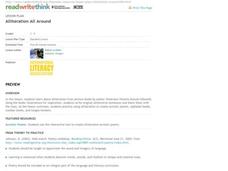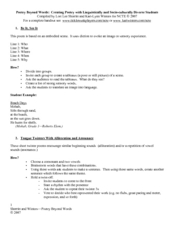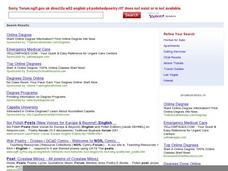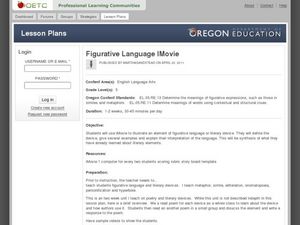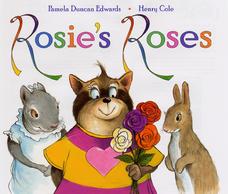ReadWriteThink
Alliteration All Around
Discover alliteration found in picture books by Pamela Duncan Edwards. Then, dive into a read aloud of Alligators All Around by Maurice Sendak. This practice sets the stage for budding poets to create their own acrostic poem, write an...
Curated OER
Different Types of Poetry
Provide pupils samples of different types of poems including haikus, narrative, nonsense, shape, and rhyming poems. In groups, class members read the poems, establish their general meaning, identify poetic devices, and rate the poems,...
Geography 360°
Poetry Writing
Put the tips and tricks in this guide into practice in order to encourage your pupils to blossom into poets. A wonderful reference material for teachers, this packet includes definitions of poetic terms and forms as well as step-by-step...
Curated OER
Genre Lesson: Poetry
Here is a terrific lesson on poetry! Learners bring in the lyrics to their favorite song. A class discussion ensues regarding what makes a song "catchy." After analyzing the alliteration of the poems, learners read the poem "This...
Poetry4kids
Alliteration and Assonance Lesson Plan
Scholars analyze the poem My Puppy Punched Me in the Eye by Ken Nesbitt in order to locate examples of alliteration and assonance. After reading the poem, alliterative words are underlined and assonant words are circled.
Curated OER
Short Poems Are Scary!
What do all those chairs and pencils do in the classroom once everyone leaves? Allow imaginations to run wild with frighteningly short poems!
Curated OER
Free To Dream Poetry
Students explore the poetry of Langston Hughes and its structure. In groups, they read poems and identify the rhyme, rhythm meter, and alliteration in each poem. Students create and illustrate their own poem, using Langston Hughes methods.
Curated OER
Poetry Beyond Words: Creating Poetry with Linguistically Diverse Students
Models of and directions for how to write 20 different types of poems are featured in an NCTE resource. The introduction to each form highlights the embedded concepts. For example, tongue twisters encourage poets to use alliteration and...
Poetry Society
How do Poets Use Language?
Why do writers choose the language they do? Here's a resource that has the poet himself answer that very question. Joseph Coelho explains why he chose the words and images he used in his poem, "If All the World Were Paper."
National Park Service
The Poet's Toolbox
If you need a lesson for your poetry unit, use two poems by Henry Wadsworth Longfellow ("Rain in Summer" and "The Slave in the Dismal Swamp") and a resource on Elements of Poetry. The lesson plan guides you through activities on...
Curated OER
Poetic Elements Are Fun!
Engage your class in the elements of poetry with a series of lessons and activities. The plans cover simile, metaphor, personification, onomatopoeia, alliteration, and imagery. Learners come up their their own metaphors, identify poetic...
Curated OER
Poetry: Simile And Figurative Language
Young scholars explore websites that contain poems about autumn, winter, and the seasonal holidays and explore how similes and figurative language can be used in poetry.
Curated OER
Poetry: A Picture of Feelings
Young scholars take a field trip to a place of interest. After the trip they share with a partner their most memorable memory about it. Later, they paint a picture representative of the trip and illustrate it with a poem using at least...
Curated OER
Teaching Selected Poems from Jim Wayne Miller's the Brier Poems
Students explore the basic elements of poetry through Appalachian life poetry. In this poetry lesson, students read seven poems from Jim Wayne Miller's the Brier Poems and complete poetry analysis activities for each poem.
Curated OER
Polished Poetry: Strange Zoo
Fourth graders use an online word list editor and software to create opening lines for a poem. They select and edit these into a complete, polished poem about an animal. They investigate parts of speech and alliteration.
Curated OER
Figurative Language iMovie
In order to understand figurative language, learners read 5 poems, each exemplifying a different literary device. They discuss and write responses to each poem. They then choose one literary device which they will use as the basis for a...
Curated OER
Edward Lear, Limericks, and Nonsense
Introduce your class to the delights of nonsense poetry and explore literary devices with the writing of Edward Lear. Learners identify rhyme and meter as well as figures of speech, alliteration, and onomatopoeia in "The Owl and the...
Curated OER
Rosie's Roses
Based on the alliterative book Rosie's Roses by Pamela Duncan Edwards, here is a resource to reinforce phonics and alliteration for younger readers. Several suggested activities would easily adapt to other books. Sparse procedural details.
Curated OER
Awesome Alliterations
Students review examples of alliteration in Shel Silverstein's poems. They are assigned a letter of the alphabet and then write an original alliterative poem using that letter.
Curated OER
Alliteration
In this alliteration worksheet, 4th graders write alliterations with their first names, find rhyming patterns in poems, and more. Students complete 4 activities.
Curated OER
Alliterations Allowed
Fourth graders recognize and create alliterative language in both literary and commercial use. For this language arts lesson, 4th graders analyze pieces of poetry and focus on the use of imagery, personification, and figures of speech.
Curated OER
Always Allow Alliteration (part 1)
Pupils identify letters and sound that are being alliterated in a text they are given. In this alliteration worksheet, students also create alliteration in words and sentences.
Curated OER
Lots of Lessons from Aesop
Aesop’s Fables offer young learners an opportunity to study figurative language. After reviewing theme, simile, alliteration, and metaphor, model for your pupils how to identify examples of these devices in the fable. Class members then...
Curated OER
Poetry in Motion
Students choose a poetry theme. They write a poem, illustrate it with digital images and record it using a digital video camera.
Other popular searches
- Poetry Alliteration Examples
- Alliteration in Poetry
- Poetry Alliteration for Kids
- Poetry Alliteration Grade 3
- Alliteration Poetry
- Poetry Alliteration Grade 9
- Poetry Alliteration Grade 4
- Poetry Alliteration Grade 2
- Poetry Alliteration for Lion
- Free Poetry Alliteration
- Alliterations in Poetry
- Using Alliteration in Poetry


